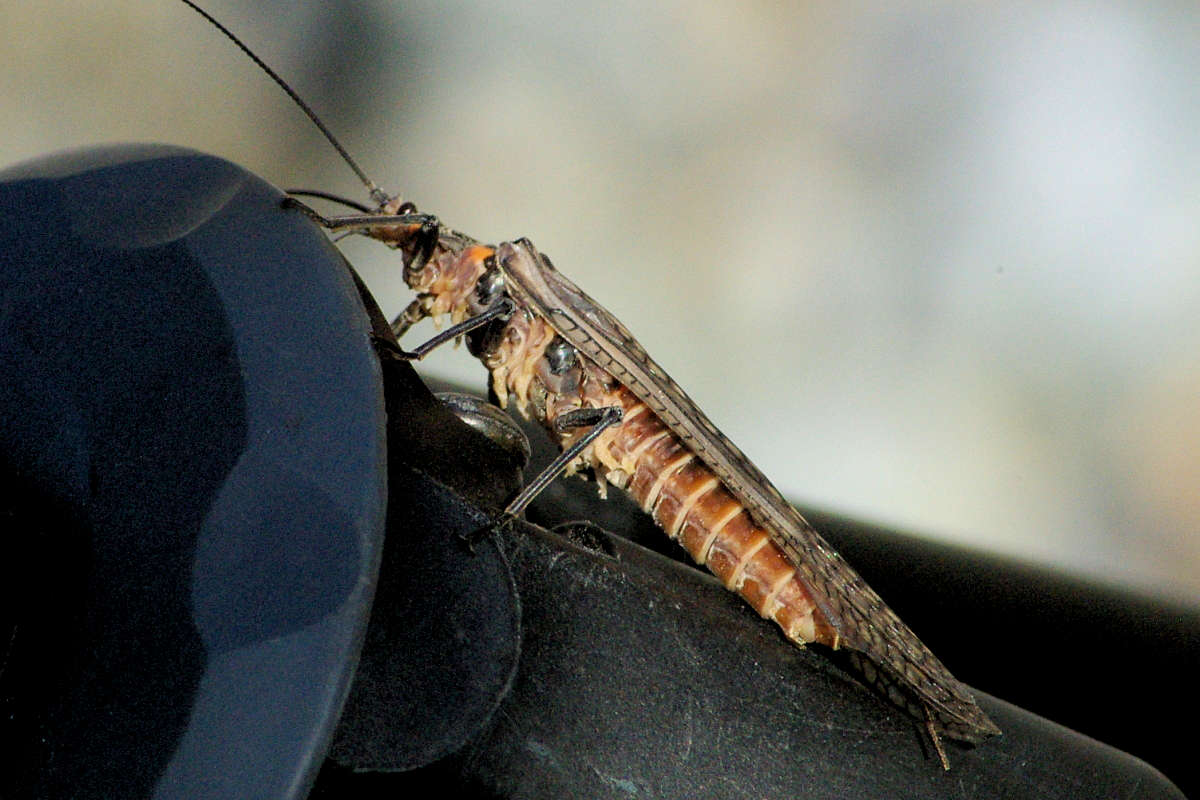By Jim Bailey
“Time,” as Thoreau put it, “is but the stream I go a-fishing in.”
Intro: For me, there is no more satisfying way to invest my time than casting dry flies to rising rainbows on the Columbia River. I may be slightly prejudiced, but for me, it is the best dry-fly fishing stream in North America. I have fished many of BC’s best, several in Alberta, multiple rivers in Alaska and the Yukon, as well as the Pacific Northwest.
None can hold a candle to the line-peeling Redband rainbows caught on the dry fly in a 50-km tailwater section of the Columbia River that flows through Trail, B.C. Not only are the trout willing, but the variety and size of hatches is mindboggling, affording anglers several dry-fly options throughout the spring, summer, and fall.
Stoneflies: The stonefly hatch in April through May is one of my favourites and catching 3-to 5-pound rainbows on size-6 adult stonefly patterns is the closest thing to nirvana one can get without actually dying.
The smaller adult form of the Golden stonefly (Perlidae) are big but the larger Giant stonefly (Pternarcys californica) also known as the salmon-fly, are huge compared to other aquatic insects. The nymph spends two to three years in the water before crawling up streamside rocks and foliage where they emerge from the shuck and morph into the adult form. They then fly off to procreate and lay their eggs on the water in an erratic and clumsy dance, that draws hungry trout to the surface.
Fishing stonefly nymph patterns is also exciting, but you can’t beat having a 20-inch rainbow trout smash a large salmon-fly pattern on the surface. Well known adult stonefly patterns include the Golden Stone, Henry’s Fork, Madame X, Chubby Chernobyl, or a large Stimulator pattern with orange or yellow body are effective.
Flying ants and Cicadas: Late April and May is the time of year for terrestrials and furious top water action with the emergence of flying ants and cicadas.
In the trout world these are a delicacy, and I’ve caught rainbows with their stomachs filled with flying black ants and/or cicadas depending on availability. Black ants have no problem flying except when they get near the river. This is when the cooler air causes them to drop to the surface and they attract cruising trout.
Use a floating line with about a nine-foot leader, and size-12 flying ant pattern on the surface in the afternoon until dark. There are several flying black ant patterns, and those tied with foam are effective and relatively easy to tie. Patterns are the Foam Ant, Black fur ant, and Flying Ant.
Cicadas: These have a unique lifecycle, with the local variety being the dog-day cicadas that emerge every four years in May, while other species emerge every 13 to 17 years.
The cicada is a plump silvery-blue colour with two large wings that lay flat against its body, and their flight, like the flying ant, often erratic, lands them in the water. Don’t be afraid to make a commotion when casting an imitation, or skate it over the surface, their struggle on the surface will attract rainbows from near and far.
Cicada patterns can be tied like a Chubby Chernobyl pattern with black or dark blue foam, with silli-legs and a stacked flashabou for the wing on size 8 hooks, or try the Super Simple Cicada, using deer hair as a wing, and a foam profile.
Caddis: The Grannom and spotted caddisfly hatch on the Columbia River and its tributaries are beyond belief. Massive clouds of caddis emerge from June into September, dancing over the water and creating a consistent and plentiful food source for feeding trout all summer long.
As a dry-fly fisher, it seems overwhelming to have to compete with billions of naturals, trying to draw a trout to your imitation. Yet, big rainbows still manage to take one of my favourite caddis patterns, as it floats amidst a crowd of emerging adults. The caddis hatch will last into the fall when the plumper October caddis hatches emerge on warm autumn days.
There are numerous caddis dry-fly patterns including the popular Elk or Deer hair caddis, tent-wing caddis, Goddard, Tom Thumb, Hemingway or the Hot Butt Caddis that uses a bright colour poly yarn on the butt as a hot spot.
The action on the Columbia for caddis adults begins early in the afternoon, but when the sun sets and darkness falls, be prepared for the real feeding frenzy to begin. After the sun sets, for a good two hours or more, large rainbows indiscriminately slash at our offerings, emptying our reels, plowing into our backing and taking long arm-busting runs before diving into the depths, then rising in a fury.
Mayflies: Mayflies are another delicacy for rainbows that come in a variety of shapes and sizes throughout the spring, summer, and fall from small baetis, and pale morning and evening duns early in summer, to Green Drakes and Hexagenia hatches, a brief but exciting time for fly fishers on the Columbia.
The hexagenia hatches on the Columbia are infrequent, but when they do come out always have an adult pattern ready, such as a Yellow Sally or a Hexagenia Paradrake. The hex doesn’t emerge until sunset, and usually in slower water less than 10 feet deep. Dress the fly with floatant. Like other big insects, it makes quite a commotion on the water, so let it drag or give it a twitch every so often.
The life of a mayfly is famously brief so make the most of the hatch whether its duns (sub-imago) or spinners (imago). The adults of some species live as few as two hours, others up to two days. In either case, their sole objective is to reproduce, and you can watch it unfold over the water; drawing rainbows to the surface either when laying eggs or having their final dance in a fatally ecstatic ‘spinner fall’.
Popular variations of mayfly adult patterns include the Adams, Hendrickson, Wullf, and Green Drake.
Hoppers: From July through September hoppers are a welcome diversion for feeding rainbows from the profuse diet of caddisflies.
Hoppers become active in the mid-morning to late afternoon and will find themselves jumping inadvertently into the river where they are completely at the mercy of hungry trout. The hopper is always fished dry and will give the fly angler some productive top water action in the heat of the afternoon sun.
Tie on a Letort, Dave’s or Joe’s Hopper pattern and drift it close to the bank, especially if accompanied by a hard landing when cast onto the river to notify trout that the hopper has arrived.
Resources: Understanding the local aquatic environment along with the when, what and how the fish feed is an important skill for any angler. You can learn more about our local insects and hatches on our Entomology Primer page. If you are not having much luck catching fish, our River Primer page can help you learn how to read the water and understand where fish like to hide.
If you need local species bait, supplies and gear, check out the growing inventory at Valley Firearms at 1281 Bay Ave. in downtown Trail. Along with the aforementioned, Valley Firearms stocks hand-tied flies from local fly-tyer Brent LaFace. The flies are immaculate and tied to target the various species of fish in the Columbia River and West Kootenay region including Redband and Gerard rainbows, cutthroat and bull trout, kokanee, walleye, and bass.







